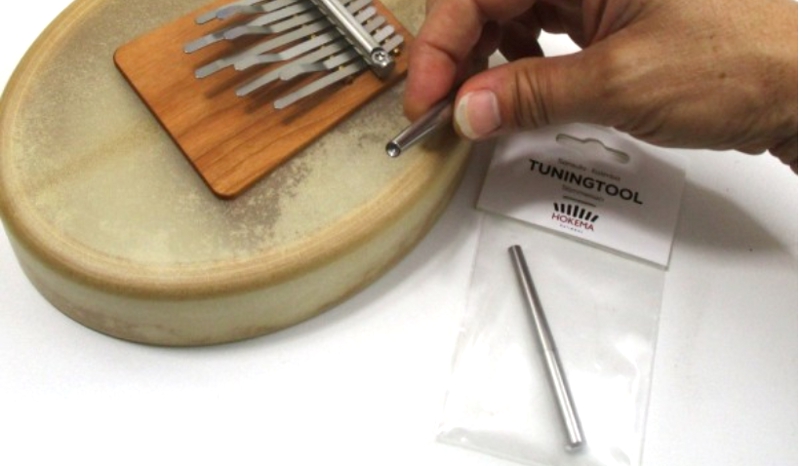Tuning your kalimba is a mixed bag. Unlike guitar, you don’t have to tune your kalimba every time you pick it up. In fact, most kalimbas will hold their tune for weeks or months.
On the other hand, once your kalimba needs tuning, you may have no idea what to do. My own favored technique is to just move the tines around by hand – but I’ve done it a time or two, and my fingers are callused in all the right places for this work.
It turns out that you can use this tiny hammer to tap the tines into tune, and there are a number of advantages to this approach.

I’ve been tuning kalimbas for over 30 years. My typical mode of tuning the kalimba tines involves grasping a tine with my thumb and index finger, and while wriggling it left and right, I either pull or push the tine to make the vibrating length longer (to play a lower note) or shorter (to play a higher note). For me, this technique works great… largely because I have done it thousands of times and I have strong hands and sensitive fingers… but also because, as you can imagine, I have some great calluses on my thumb and index finger right where I grasp the kalimba tines. (My message to you: While the “by hand” tuning technique is both economical and effective, it may cause you pain if you don’t have those calluses… and if you use the “by hand” technique and you are not as experienced as I am, you probably won’t quite have “the touch” and will not be able to tune your kalimba as accurately and you may wish.)
However, there is another way to tune: By hitting the tines gently with a tiny (get it?) hammer. These hammers are made in China by the same company that makes our Heart-10 and Heart-17 kalimbas. Those heart kalimbas automatically come with the tuning hammers. However, Hokema, Hugh Tracey and Goshen kalimbas do not come with the hammers automatically.
I find that the smallest hit you can do with these hammers will not produce any movement of the tine. As you gain experience tuning with the hammer, you will probably develop a “standard whack strength” of about 5 cents. (There are 100 cents in a half step.) I find that I can tune kalimba tines with a typical error of about 2 cents with a maximum error of 5 cents by using a tuning hammer, giving even smaller whacks as I get near to my tuning target. If you only use your “standard whack” it will take you 20 whacks to move a half step. If you are just touching up on your tuning, you will only be adjusting the tuning of each tine by a small fraction of a half-step, so a “hammer only” method is fine. However, if you are retuning a tine by more than a half-step, you may want to do a rough retuning by hand, followed by a fine tuning with your hammer.
Note that these hammers are too tiny (get it?) to adjust the tuning of the more massive tines on the mbira dzavadzimu. They will, however, work great on Sansula, Hugh Tracey, and any of the newer Chinese-made kalimbas.
You might ask: “How is this tiny tuning hammer related to the Hokema tuning tool?”

The Hokema tuning tool is a metal cylinder a few inches long with a concave indentation on one end that will grasp a tine. While it was designed to grasp a 4mm wide Sansula tine, it can also grasp a 5mm Alto kalimba tine. It will grasp the tine, and you have to supply some umph to accomplish tine motion and retuning. That umph could be from your hand, pushing the Hokema tuning tool to move the tine… or the umph could be supplied by a tuning hammer, tapping on the tuning tool, which effectively transmits the force to the tine. That is, while the Hokema tuning tool and the tuning hammer are independent tools that deliver benefit all on their own, they can also be used together.


Sign up for our newsletter and free resources with your email address:
We pinky promise not to spam you and to only send good stuff.
 Christmas in July 2025
Christmas in July 2025 Patriotic and American Music for Kalimba
Patriotic and American Music for Kalimba